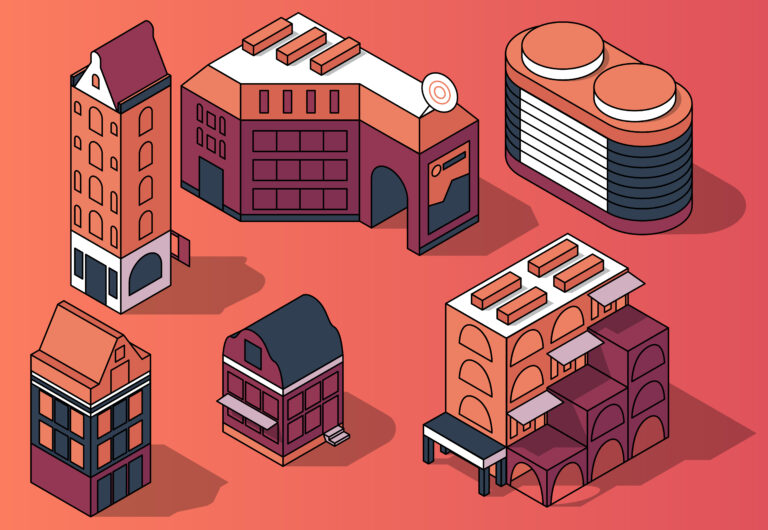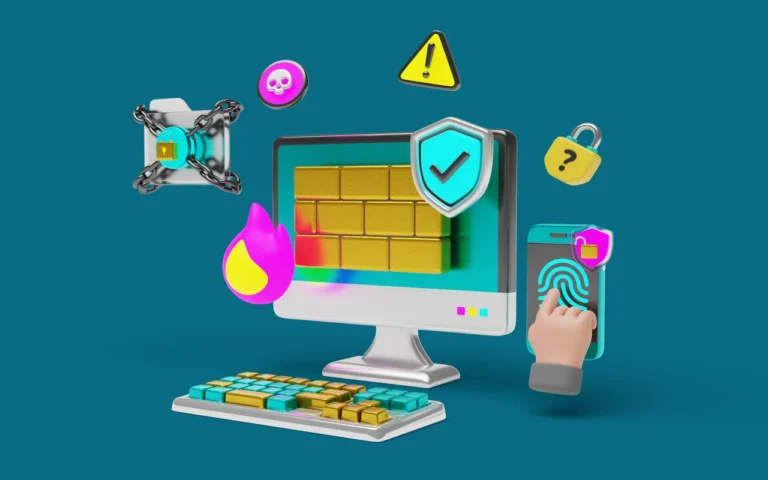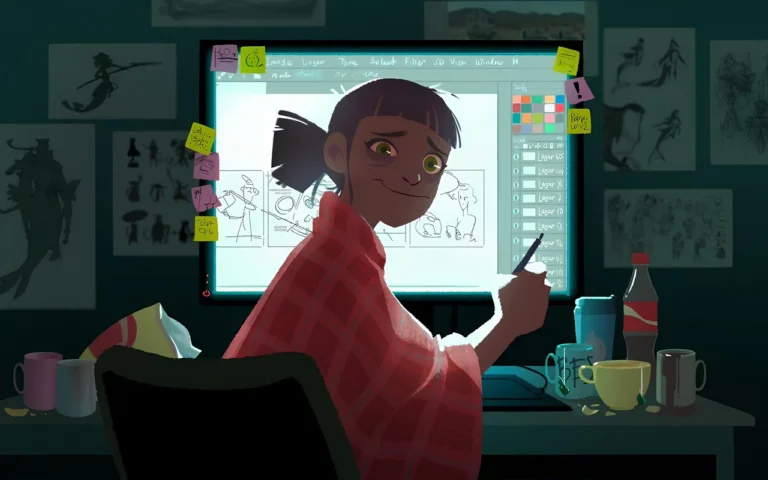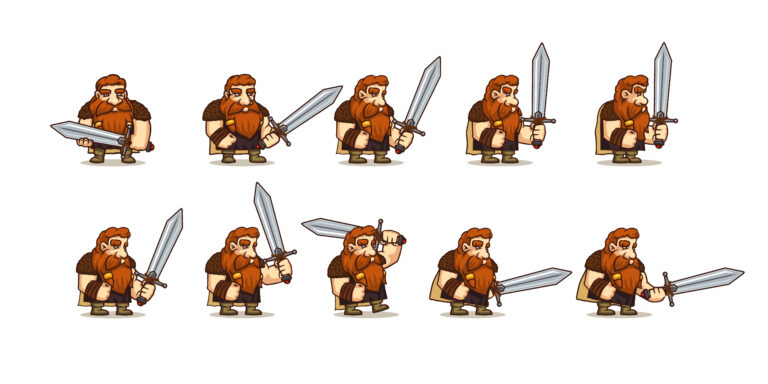If you’re considering the journey into game development, animation, or app design and you have a need for 3D outsourcing services, you may be asking: What will it cost for 3D art outsourcing? The short answer is, 3D art outsourcing cost can be highly variable! Knowing what a normal cost is going to look like will allow you to at least create a budget, and at best, it can help define a baseline of expectations for your project.
In general, a low–poly model will cost you around $50-$150, but more complicated and detailed models, scenes, characters, etc., could be anywhere from $500 – $5,000 to possibly even more! Typically, the final price is evaluated based on asset category, complexity of the asset, artistic style, sourcing studio location, and the skill level of the team you are receiving services from.
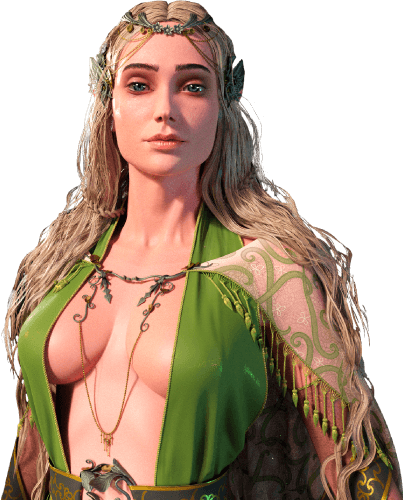
Need 3D Animation Services?
Visit our 3D Animation Service page to see how we can help bring your ideas to life!
Understanding 3D Art Outsourcing: Who Needs It and Why?
3D art outsourcing isn’t just a way to save money anymore—it’s a strategy for studios looking to increase production velocity, while still managing visual fidelity with access to a global workforce. Whether you’re an indie game developer about to launch your first mobile game or a AAA game studio preparing for a blockbuster cinematic release, outsourcing allows you to plug into a system that can improve your workflow and bump up your creative utilization and innovation, wherever that is needed.
So let’s look at some of the types of users that are benefiting the most from 3D art outsourcing and how it is now being utilized as an all-industry level game-changer:
Game Development
Game studios outsource 3D art to balance an ever-rising demand for quality, animation-ready characters, environments, and VFX in 3D animation, movies, and video games without loading up their in-house team. From mobile-friendly low-poly game art assets to hyper-realistic characters for next-gen consoles, 3D art outsourcing can give studios the leverage and flexibility they need at all stages of the development process.
Read More: High vs Low Poly Modeling: Complete Guide To 14 Differences
Film and Animation Production
While working on films and animation, detailed 3D models and CGI video sequences require specialized skills and extremely powerful pipelines. Receiving 3D art services from outsourcing studios to deliver cinematic-quality assets—from fantasy creatures to futuristic cityscapes—can be done at a fraction of the in-house cost.
AR/VR Projects
Augmented and virtual reality environments require optimized 3D assets to perform in a real-time situation. The challenges of designing a great game environment apply here too. Working with studios reliant on a solid AR / VR pipeline will ensure your assets are okay and optimized, are interactive, and are appropriate for an immersive medium.
Product Visualization
Retail, e-commerce, and manufacturing job sectors use 3D product visualization to create photorealistic renders of their products for prototypes, marketing, or digital catalogs. The role of animation in marketing is also crucial here, as brands hire an outside 3D studio to help minimize their reliance on physical samples and achieve quicker time-to-market timelines.
Architecture and Engineering
Architects and engineers will use the 3D modeling process to create visual representations of buildings, interiors, and infrastructures to show clients or stakeholders. Third-party 3D studios will take your models and give you incredible results with photorealistic renders, walkthroughs, or interactive simulations to flatter clients or stakeholders.
If you’re a startup that doesn’t have an in-house art team or an established studio ramping up for a big release, outsourcing enables you to scale quickly, maintain consistent quality, and deliver to tight timelines without the possibility of burnout. It is not merely a conversation around saving costs; it is a conversation of leveraging creative potential with the appropriate external partners.
Different Types of 3D Art and Their Outsourcing Price

Not all 3D assets are created the same. They all have varying production pipelines, tools, and skillsets. Whether you are creating game-ready assets like characters for a narrative-driven RPG, props for mobile, or massive environments for an open world experience, the cost of developing 3D outsourced assets is largely dictated by the type of asset and technical complexity.
Here is a breakdown of the most common asset types and how their production drives their asset outsourcing cost:
Characters: The Most Complex Assets
Designing characters in 3D is a multi-faceted and multi-step process involving 3D sculpting, retopology, UV mapping, texturing, rigging, and animation. The price and time may vary greatly depending on whether stylized or photorealistic models are built, as well as facial rigging/blend shapes for emotional expressions.
- Average price: $500 – $5,000+ per character
- Used in: Games, animation, cinematics, AR/VR avatars
- Why it’s expensive: All character designs are often front-facing. They usually also require emotional expressions, which require not only design work, but animation pipeline, rigging, etc.
Environments: Large-Scale and Resource-Heavy
3D environments involve sculpting of terrain, modular assets, (walls, floors, buildings), lighting, and sometimes particle effects. Scenes need to be optimized for reasonable performance and still deliver an immersive visual experience which makes them complicated to build and time-consuming.
- Average price: $1000 – $10000+ per scene
- Used in: Game levels, simulations, architectural walkthroughs
- Why it’s expensive: Because they usually cover large areas, support gameplay and interactivity, and require visual consistency.
Props and Items: Small but Essential
Props refer to simpler objects, such as furniture, tools, weapons, or collectible items designed by a prop artist. Although props involve modeling/texturing, typically, rigging and/or complex shaders will not be required.
- Average price: $50 – $500 per prop
- Used in: Games, animations, product visualizations
- Why they cost less: Generally, props are normative, standalone objects that creators will often reuse or repurpose, and that’s why the production time is very minimal.
Vehicles: Technical and Stylized Challenges
Vehicles, including cars, spaceships, tanks, etc., require a great amount of detailed modeling, both the exterior and the interior. The costs will vary based on whether animation or rigging is also required (for example, animating the wheels or making the cockpit interactive).
- Average price: $500 – $3000 per vehicle
- Used in: Racing games, sci-fi games, simulations
- Why it’s tricky: Realism, rigging mechanical parts, and material shaders all add a level of complexity.
UI Elements: Functional and Artistic
User interface items, particularly 3D art style elements in a stylized game or in a futuristic interface, need design rationale, animation, and optimization for responsiveness.
- Average price: $100 – $800
- Used in: Game heads-up displays, augmented reality dashboards, futuristic apps
- Why pricing varies: The cost is based on the complexity of animation vs. platform (mobile/desktop/console) and interactivity.
Real-Life Examples of 3D Art Outsourcing Costs
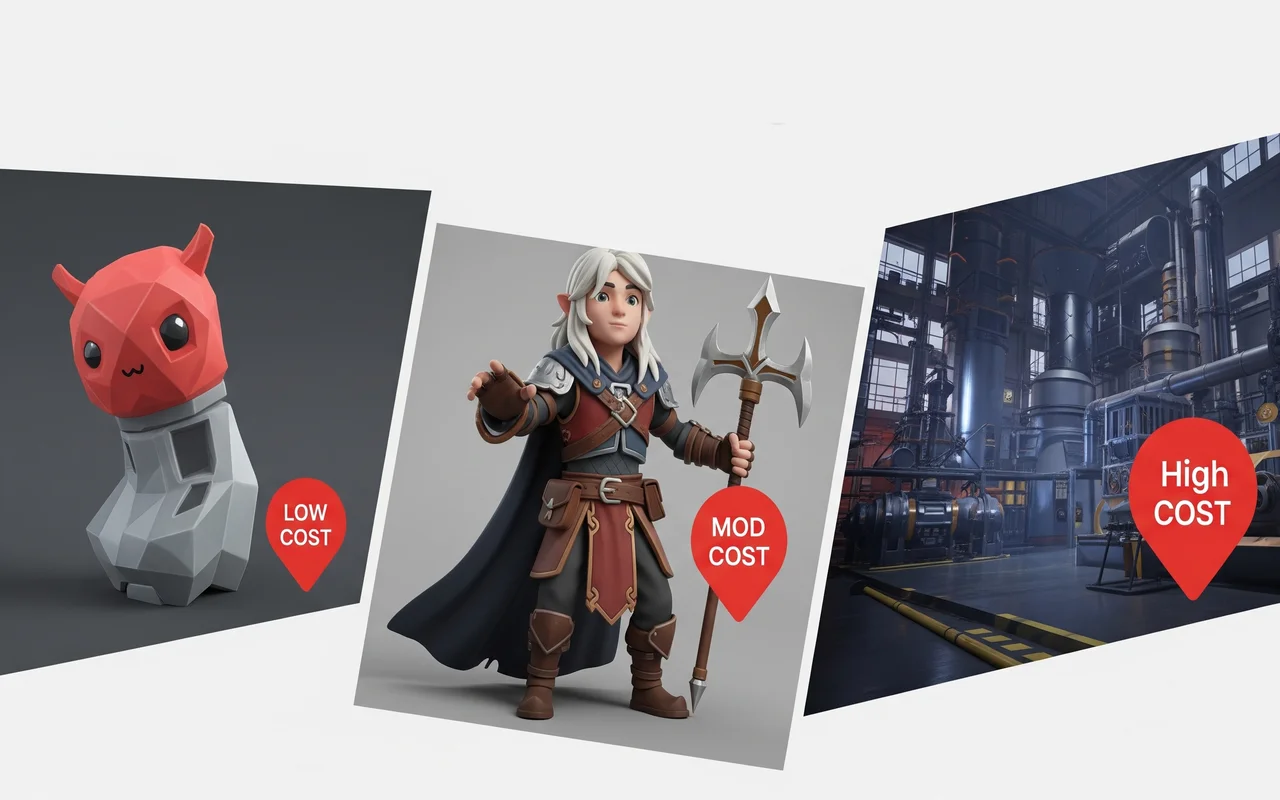
Pricing for 3D outsourcing isn’t just numbers; it falls under the influence of the scope, style, and storytelling ability of each asset added. Here’s what that looks like in actual projects:
Stylized Props for a Mobile Game — $1,000 Total
A mobile game studio wanted a handful of stylized low-poly props such as crates, vases, and torches, 10 total. Since the stylized props didn’t require advanced textures or unique or specialized shaders, the artist was able to deliver the total pack within a week for a total of $1,000.
Why So Affordable?
Outlining simple geometry without complex materials, shared texture maps, and little polish means the production will cost less.
Rigged Fantasy Character for an Indie RPG — $3,500
A mid-sized studio had asked for a playable character with high-res textures, armor variants with facial rigging for dialogue scenes, as well as running, casting, and idle animations. The total landed around $3,500.
What Drove The Price Up?
Detailed sculpting, animation complexity, and layered texturing add up to the price, but the outcome is beyond satisfactory.
VR-Ready Industrial Environment — $8,000
A VR company needed a full-scale warehouse, equipped with a lighting system, interactive machinery, and modular design components. The studio that completed their project optimized all the textures and meshes on all the assets for peak performance on various VR platforms—costing $8,000.
Was it worth it?
Yes. An optimized level of realism for immersive learning means you must pay attention to detail and refine your assets.
What This Tells You
The bottom line? The price of 3D outsourcing scales with precision, level of detail, and interactivity. What one studio will price an asset at $50 may cost another studio $5,000, because each asset represents a different story, and every project has its own technical hurdles to overcome.
Factors Influencing 3D Art Outsourcing Cost
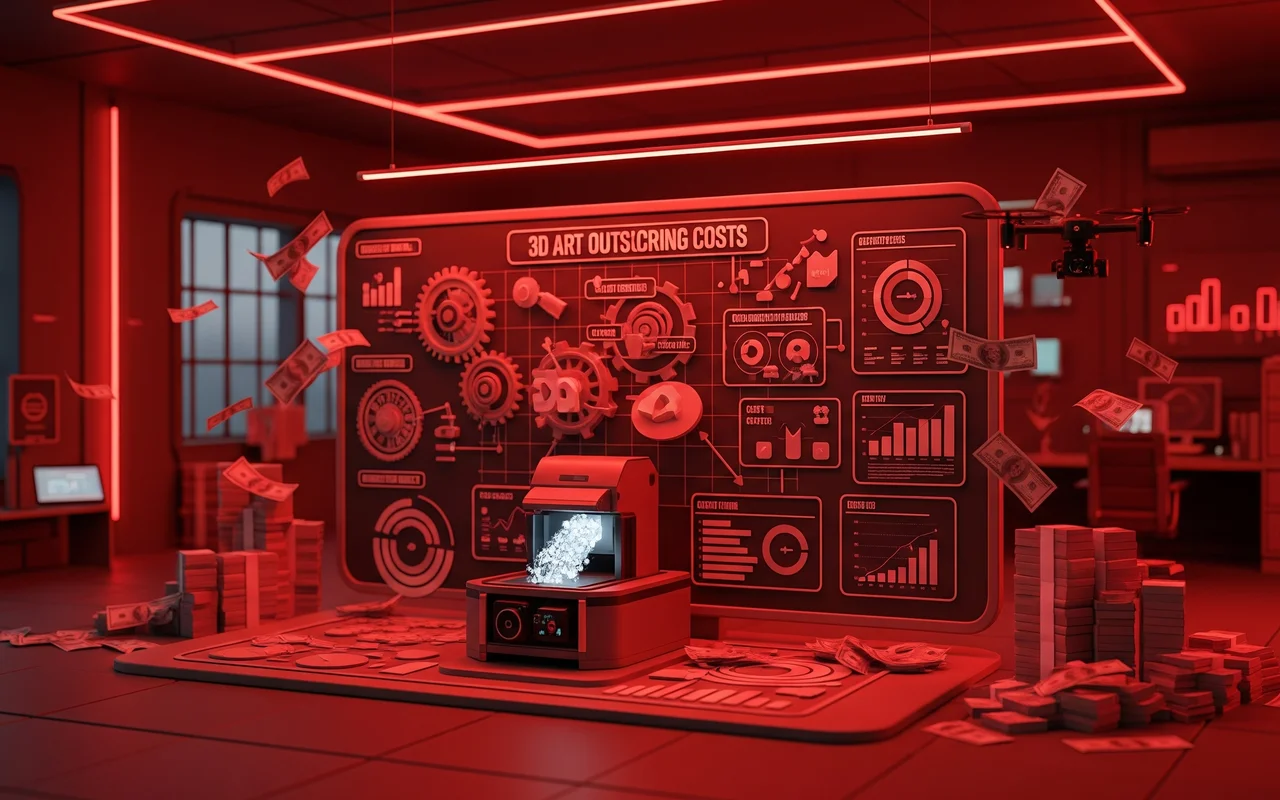
Outsourcing 3D artwork is a complicated process. Many factors will determine what it ultimately costs, and when you take these factors into account, you can make better decisions, manage the budgets, and avoid unwanted invoices. Now let us discuss each of these factors in more detail:
Project Complexity and Scope
The more complex your project, the more expensive it will be. A basic, low-poly game art object may take a few hours of work, while a full model with textures, rigged animations, and physics-based interactions could take weeks.
- Easy scope: Static props or background objects (rocks, crates)
- Medium scope: Rigged characters or interior spaces
- High complexity: Fully animated characters, interactive spaces, or entire game levels
Also, larger projects with many different asset types usually take longer, involve multiple members, and require intense project management.
Read More: High vs Low Poly Modeling: Complete Guide To 14 Differences
Level of Detail and Art Style
Visual style has a direct influence on the workload, as well as the budget:
- Realistic 3D (applied in AAA titles or in cinematic teasers) comprises high-end texturing, photorealistic lighting, and high-poly modeling. They require more time and professional artists.
- Stylized 3D (usually in mobile game art styles or indie games) is less expensive as it is made up of simple geometry and textures
- Low-poly styles (used in performance-optimized games like RTS or mobile) are faster to produce and less expensive.
With more detailed textures, you would need a higher resolution, resulting in more time-consuming work and higher prices.
Read More: Art Styles in Indie Games vs. AAA Games
Number of Assets Required
Ordering a single asset can be more expensive per unit than ordering a batch.
- For an entire game level with dozens of assets, you have more negotiating power on a per-asset basis.
- Bulk orders help studios optimize their pipeline, making it a win-win.
- Fewer, more advanced assets can be more expensive than many simple ones—so budget for your game’s look and what matters most.
Many outsourcing studios offer volume discounts or packages for large orders.
Experience and Location of the Outsourcing Team
Labor price varies globally. One approximate calculation is as follows:
- North America & Western Europe: $50–$150/hr — top-end rate for high-quality work
- Eastern Europe & Latin America: $25–$75/hr — great quality at affordable prices
- South Asia & Southeast Asia: $10–$50/hr — affordable rates, variable quality
But more costly usually translates into better communication, eminent pipelines, and faster turnarounds. It’s not cost but value.
Software and Technology Requirements
Growing software requirements can lead to increased costs, especially when they involve:
- Costly licenses (e.g., Autodesk Maya, Substance Painter, Houdini)
- Real-time rendering engines (e.g., Unreal Engine 5 or Unity)
- Custom plugins (e.g., Marvelous Designer for cloth simulation or SpeedTree for foliage)
Additionally, if you require file formats optimized for specific platforms (such as game engines, AR/VR games, or film rendering), this adds to the technical complexity and cost.
Turnaround Time and Deadlines
If you’re on a tight schedule, expect to pay more. Urgent deadlines might entail:
- Overtime work
- Additional team members
- Top priority over other projects
Most studios have standard, express, and rush pricing tiers. Preplanning ensures smoother collaboration and better rates.
Revisions and Feedback Loops
Revisions are inevitable, but excessive iterations indicate delay and higher expenses.
- Some studios offer limited free revisions
- Some charge per round beyond the initial scope
To save time and money, provide clear references, brief descriptions, and organized feedback at each milestone.
Intellectual Property and Licensing Fees
You might need to own all rights to the 3D assets—especially if you are selling them, are going to use them in a commercial workpiece like a commercial animation, or even are going to patent them.
- Some studios retain rights unless explicitly transferred, and that comes at an extra cost.
- Always clarify IP terms in the contract—especially if you’re outsourcing characters or designs tied to your brand or story.
Not doing so can lead to legal trouble in the future. By taking these into account, you would have a smooth path ahead of you.
Communication and Project Management Tools
Seamless communication is essential for effective outsourcing. Among some of the tools used by some of the studios are:
- Asana or Trello for project management
- Slack, Discord, or Skype for messaging
- Miro or Figma for visual feedback and co-designing
If these tools aren’t provided or used efficiently, it could slow down the project and lead to extra costs. Studios that spend more on professional pipeline management charge more—but deliver smoother, more professional results.
How to Save Money on 3D Art Outsourcing

Need professional results without breaking the bank? Here are a few smart tips:
- Plan ahead to steer clear of rush fees.
- Batch your assets to get better rates.
- Use stylized over hyper-realistic when possible.
- Provide a clear brief to save time on revisions.
- Collaborate with studios in affordable regions without sacrificing quality.
- Applying existing asset libraries to accelerate props or backgrounds.
How to Choose A 3D Game Art Outsourcing Studio
Choosing the right partner for your 3D game art pipeline is the key to success. Remember the following:
- Check portfolios for suitability of style.
- Ask about pipelines—from modeling to delivery.
- Check client testimonials or reviews.
- Confirm ownership rights and NDAs.
- Communicate expectations early regarding feedback loops and turnaround time.
What Are the Benefits of Working with A 3D Art Outsourcing Studio?
Employing a professional studio has multiple advantages:
- Scalability: Employ more artists as your project grows.
- Expertise: Utilize special skills like sculpting, rigging, or shader development.
- Cost-effectiveness: Save on salaries, software, and HR overhead.
- Time-saving: Focus your internal team on core development.
- Quality assurance: Completed, high-quality output with consistent style.
How Pixune Studios Can Help You With 3D Art Outsourcing?
We at Pixune Studios bring your imagination to life in breathtaking world-class 3D graphics, tailored to your needs and budget. Whether you’re building a fantasy RPG or a VR training app, we offer:
- 3D Sculpting
- 3D Rendering
- 3D Modeling
- 3D Character Modeling
- 3D Texturing
- 3D Rigging
- Hard Surface Modeling
- 3D Retopology
With a proven track record in game development and animation, we’re here to streamline your 3D production pipeline from start to finish.
